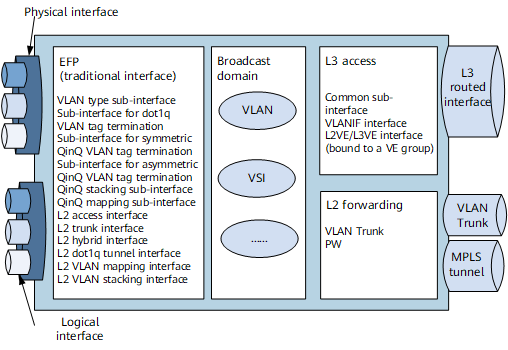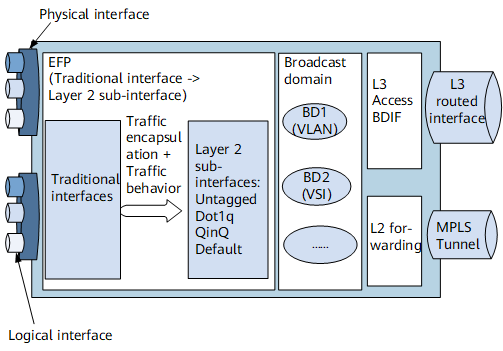Overview of EVC
EVC a model transmitting Ethernet services, but is not a specific service or technique.
Definition
An Ethernet virtual connection (EVC) defines a uniform Layer 2 Ethernet transmission and configuration model. An EVC is defined by the Metro-Ethernet Forum (MEF) as an association between two or more user network interfaces within an Internet service provider (ISP) network. In the EVC model, a bridge domain functions as a local broadcast domain that can isolate user networks.
An EVC is a model, rather than a specific service or technique.
Purpose
Figure 1 shows the traditional service model supported by the NetEngine 8000 F.
Figure 1 Service model of the NetEngine 8000 F
The NetEngine 8000 F's current service model has limitations, which are described in Table 1. The EVC model addresses the limitations and was introduced shown in Figure 2.
Figure 2 EVC model
Table 1 provides a comparison between the traditional service model and the EVC model of the NetEngine 8000 F.
Table 1 Comparison between the traditional service model and the EVC model of the NetEngine 8000 FService Object
|
Traditional Service Model
|
EVC Model
|
|---|
Ethernet Flow Point (EFP)
|
Sub-interfaces and Layer 2 physical interfaces, which have various types and require different configurations.
|
EVC Layer 2 sub-interfaces only. Configurations are unified on the Layer 2 sub-interfaces. The configurations include traffic encapsulation, traffic behavior, traffic policy, and traffic forwarding. A traffic encapsulation type can be combined with a traffic behavior to form a traffic policy, allowing different services to be transmitted through different Layer 2 sub-interfaces.
|
Broadcast domain
|
Virtual local area network (VLAN) for traditional Layer 2 services
VLANs are used as broadcast domains on MANs. The VLAN tag field defined in IEEE 802.1Q has 12 bits and identifies only a maximum of 4096 VLANs.
QinQ was developed to address the shortage of VLAN ID resources. However, QinQ must be used with the virtual private LAN service (VPLS) to provide local switching services, and QinQ cannot implement local switching services and Layer 3 access at the same time.
Virtual switching instance (VSI) for VPLS services
- A customer can plan VLANs and traffic within a VSI.
- When VLAN services are carried within a VSI, the VLANs are not isolated, posing security risks. If the same MAC address exists in multiple VLANs of a VSI, MAC address flapping occurs, affecting services.
|
Bridge domain (BD) - A BD provides local switching of VLAN/QinQ services.
- Different BDs can carry services from the same VSI, and services are differentiated using BD IDs. BDs are isolated from each other, and MAC address learning is based on BDs, preventing MAC address flapping.
|
Layer 2 forwarding
|
- VLAN Trunk: transmits VLAN services.
- Pseudo wire (PW): transmits Layer 2 virtual private network (L2VPN) services.
|
-
|
Layer 3 access
|
VLANIF interface: terminates Layer 2 packets and provides Layer 3 access.
A VLANIF interface terminates single-tagged packets rather than double-tagged packets.
L2VE and L3VE interfaces bound to a VE-Group: terminates L2VPN services and provides L3VPN access, respectively.
L2VE and L3VE interfaces must be bound to the same VE-Group when sub-interfaces for dot1q or QinQ VLAN tag termination are used to provide Layer 3 access. The configurations are more complicated than those of VLANIF interfaces.
|
BDIF interface: terminates Layer 2 services and provides Layer 3 access.
|
Benefits
EVC provides an Ethernet service model and a configuration model. EVC simplifies configuration management, improves operation and maintenance efficiency, and enhances service expansibility.

